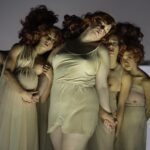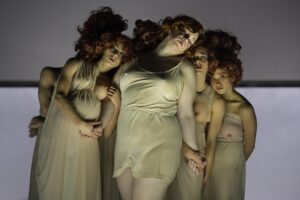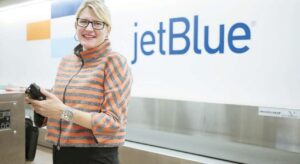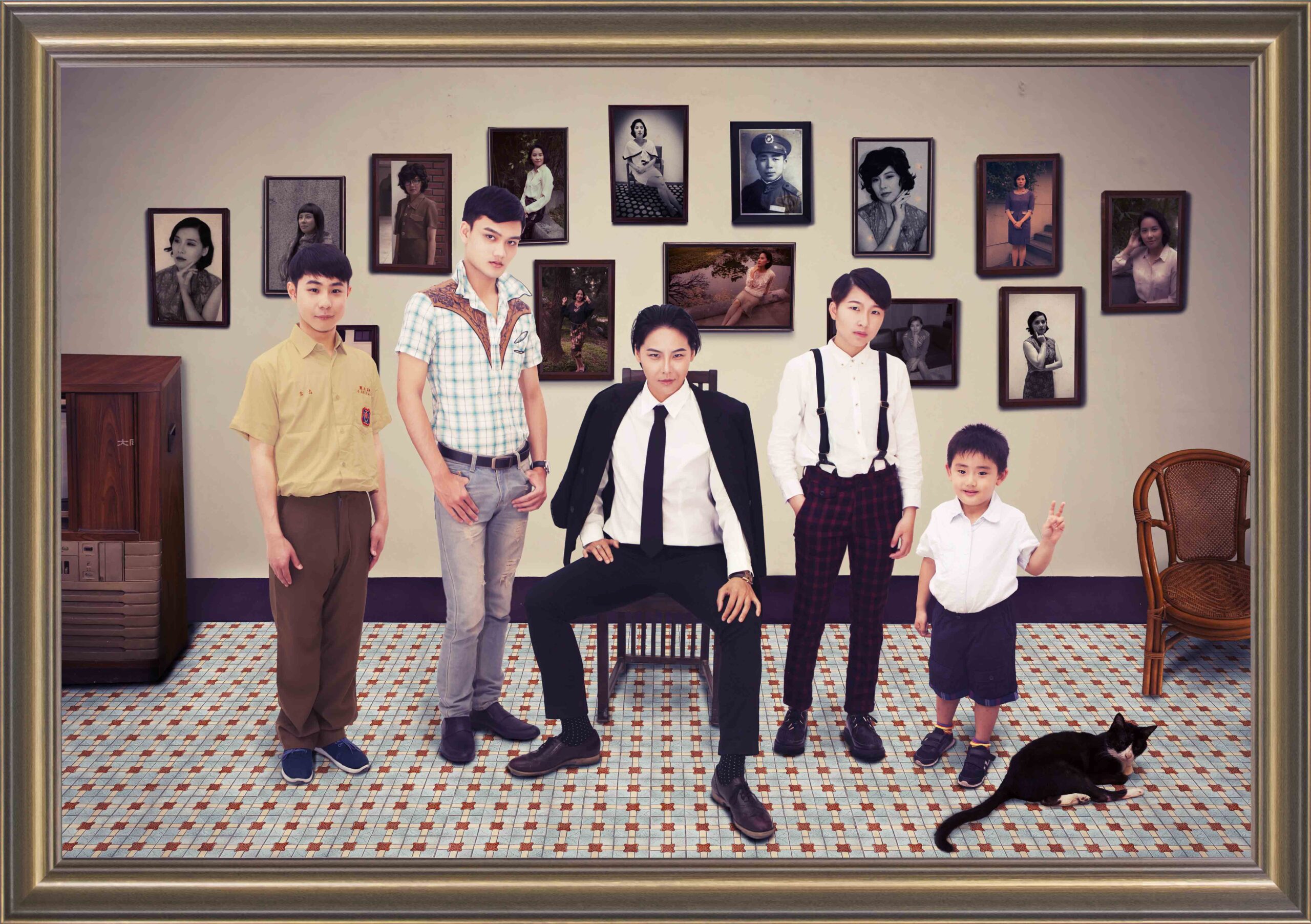
Chinese Cultural Center’s “WOMEN我們: From Her to Here” Gives Viewers A Revealing Look Inside Queer Asian Feminists’ Daring, Defiant, And Vulnerable Experience
by Heather Cassell
Growing up in San Francisco, home to the United States’ largest historic Chinatown, and a multitude of Asian nationalities, I quickly learned negotiating queerness was a tricky subject among my Asian lesbian, gay, bisexual, transgender, queer, and intersex partners, friends, and acquaintances.
These complexities are explored at the “WOMEN我們: From Her to Here” exhibit currently showing at the San Francisco Chinese Cultural Center.
The third iteration in the series exploring Asian women’s experience and expression through art focuses on queer Asian and Pacific Islander women’s experiences from the San Francisco Bay Area across the Pacific Ocean to China, Hong Kong, Taiwan, and other parts of Asia.
The exhibit is a part of an ongoing series exploring feminism, gender diversity, and sexual equality.
The Mandarin word for women is a homophone meaning both “women” and “we,” the pamphlet that guides guests through the three-room exhibit explains.
“We” represents agency and belonging, affirming our need to sustain safe physical and psychological spaces in a way to nourish queer and feminist creativity and cultural growth, according to the pamphlet.
The 12 artists’ works on display at, “WOMEN我們: From Her to Here,” express their Asian heritage, queerness, and feminism both the darker aspects of homophobia, exoticism, racism, and sexism to celebrating their uniqueness utilizing film, photography, literature, painting, and sculpture in this mixed media art show.
The artists presented in this exhibit, include Hansheng Chen, Yao Hong, Heesoo Kwon, Madeleine Lim, Huang Mengwen, Carlo Nasisse, Nicole Pun, Tina Takemoto, Brad Walrond, Chelsea Ryoko Wong, and Kuka Yuanyuan Yang.
Literature was incorporated into the exhibit with the “The Queer Reads Library: A Selection” where Bay Area artist J Wu carefully curated 20 zines with Mixed Rice Zines from the Queer Reads Library explore the lexicon of “language and locality.” The language and personal reflections are unlocked by a digital zine created specifically for the exhibit accessed through the Queer Reads Lexicon’s QR code with their phones at the exhibit.
“I feel that queer Asian diasporic experiences are a complex yet often overlooked perspective that I hope to highlight through the exhibition,” said Hoi Leung, the exhibit’s 25-year-old curator.
“As someone who identifies as a queer immigrant from Hong Kong, I always wanted to portray queer Asian diasporic expressions as an entry point to explore what it means to live liminally, occupying an in-between-ness that is both daunting and freeing at the same time, she continued.
“The most important aspect of feminism that I try to uplift through AAPI voices is how diasporic experiences inform our understanding of queerness and feminism, and vice versa,” she said.
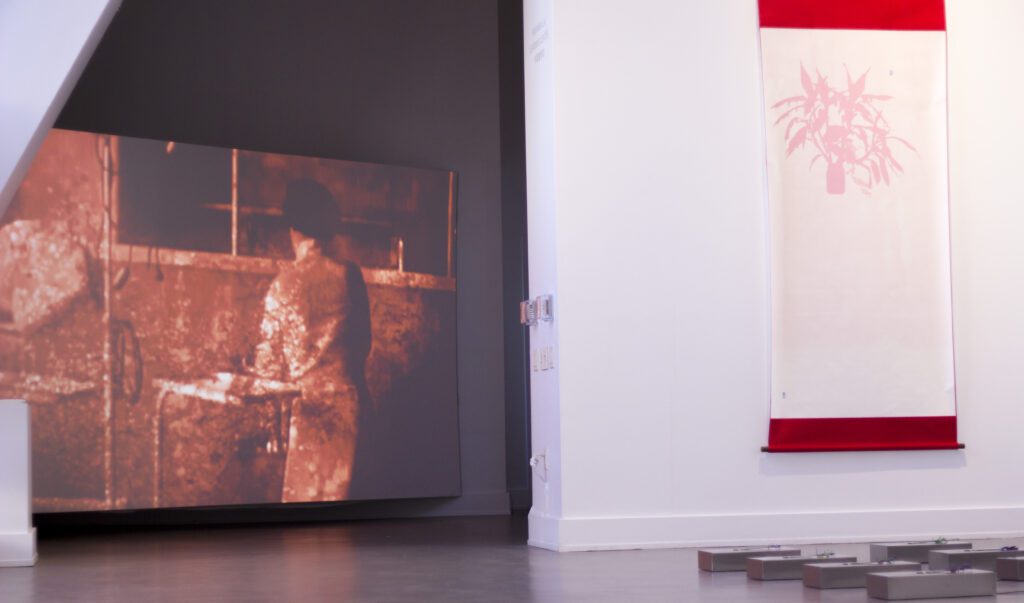
Asian and Queer
Chinatown and the queer community have a long complex history that is beginning to emerge from the shadows of history.
Tina’s experimental short abstract biography, “Ever Wanting (for Margaret Chung) (2021),” about America’s first Chinese American woman doctor who was an indomitable force and whose affairs with women were notorious hints at Chinatown’s early 20th-century influence on San Francisco’s emerging queer community.
Asia and here in the Bay Area have progressed in terms of LGBTQI rights. During the last 100 years, the LGBTQI community began to identify and name itself and claim its space in this world.
Taiwan, the semi-autonomous island of the Republic of China, became the first place in Asia to legalize same-sex marriage in 2019.
The year before, India struck down its British colonial-era law, Section 377, which was used to criminalize LGBTQI people. Various versions of the penal code law are prevalent throughout Asia and Africa, a relic of colonialism on the continents.
Within the 21st century, LGBTQI Asians began to assert themselves even more abroad following their peers in the Western countries, establishing queer organizations and Pride celebrations that continue to emerge throughout the continent.
In the Bay Area, many LGBTQI Asian organizations established themselves and have thrived since the late 20th century into the 21st century, the latest being the first-ever Chinatown Pride established in 2018.
However, it is clear, that the complexities navigated by queer Asians from different Asian ethnicities and nationalities to newcomers to America remain as same-sex love continues to be a taboo.
The Exhibit
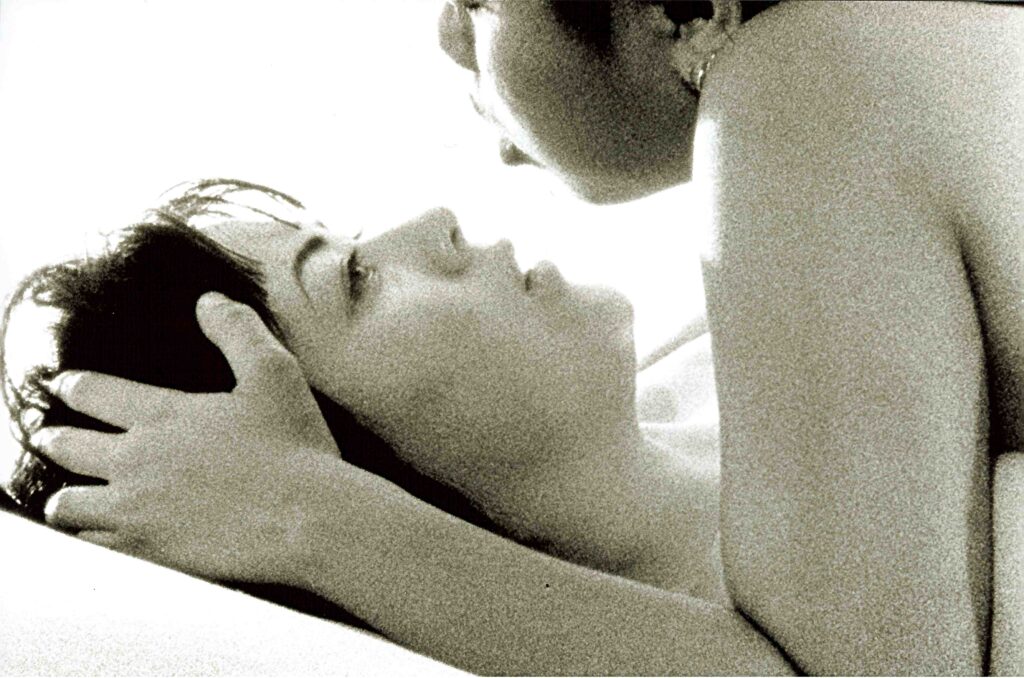
But it is Tina Takemoto’s experimental short abstract biography, “Ever Wanting (for Margaret Chung) (2021),” about America’s first Chinese American woman doctor that sets the tone for the exhibit from its position radiating out from the last room. The abstract biography can be seen throughout the gallery.
“I placed Tina Takemoto’s work at a spot in the gallery that is visible throughout the entire exhibition,” said Hoi. “I wanted Chung’s aura and Takemoto’s visual poetics to resonate in the entire show—feelings of how queer, how romantic, how liberating, yet dangerous it all is.”
Dr. Margaret Chung called Chinatown her home in the 1920s, but due to her dual American-born and her Chinese roots and romantic affairs with women, she spent her life navigating between racism, sexism, and homophobia. An indomitable and controversial figure, the trifecta held her back despite her incredible accomplishments as a doctor to celebrities and the navy and the establishments of the Women Accepted for Volunteer Emergency Service, better known as the Naval reserves’ WAVES, and the Chinese Hospital, which still exists today.
Hoi quoted Tina, “My goal was to make a film that conveyed some of the more complicated aspects of Chung’s life and character. I tried to imagine how it felt to be driven by such strong desires for women and celebrity within worlds where she was always an outsider.
“Tina Takemoto has expressed that the work is about Chung’s ever wanting sense for belonging, but never quite fully achieving it,” Hoi added. “We can look at Chung’s life’s work and admire it for all its unapologetic complexibilities, but there’s a feeling that she was never fully satisfied in this predominantly heteronormative white male system.”
“It’s important to include this work because it captures Chung’s life as one that is dynamic and exceptional, yet due to the systematic racism, sexism, and homophobia, she was trapped in a loop of never fully negotiating all parts of herself all at once,” continued Hoi.
The 1920s were rife with discrimination, San Francisco’s Chinatown provided a sense of freedom as a space for outsiders during the Chinese Exclusion Act and the Prohibition era. The exoticism of another world and freewheeling spirit attracted predominantly white bohemian artists, celebrities, and queer people who called Chinatown home as well as their playground with its bathhouses, night clubs, and speakeasies.
The exhibit opens with Singaporean American filmmaker Madeleine’s 1997 “Sambal Belacan in San Francisco,” which was banned in her homeland for more than 20 years.
“The spaces in Chinatown in the 20s through the 40s have always attracted people who want to live a life that is liminal and boundless, Hoi said.
“Against the backdrop of a neighborhood segregated due to racism and stereotypes of exotic sexualities, the speakeasies, clubs, art venues have all contributed to a nightlife that provided a marginal space where LGBTQI people can lead a non-normative life—one that enables them to experiment with and express their fullest selves,” she added.
That ability to experiment and express their fullest selves, is something that Madeleine, a 57-year-old butch queer woman of color, only achieved in San Francisco, not in her homeland, Singapore, where the LGBTQI community continues to struggle against the country’s conservative government.
Madeleine immigrated to the United States in 1987 due to being persecuted by the Singaporean government for her LGBTQI activism.
In the US, she founded and is executive director of the Queer Women of Color Media Arts Project, which teaches queer women of color how to make their own films that are premiered at the Queer Women of Color Film Festival every June.
Even today, she still cannot be completely herself in Singapore.
After 23 years, her 25-minute award-winning documentary, “Sambal Belacan in San Francisco,” was finally seen by a limited audience last year. The Singapore International Film Festival (SGIFF) allowed 33 people to watch the film and participate in a controlled virtual question and answer session due to the pandemic and government oversight at a one-night screening. Officials at the Intercomm Media Development Authority, which rates media in Singapore, gave the film an R21 rating, the highest rating for mature audiences in the Southeast Asian island city-country.
The film is based on the conversations the women had at Madeleine’s monthly Singaporean and Malaysian bisexual and lesbian potluck that she hosted for a decade. It explores the women grappling with homophobia in Singapore, racism in Singapore and the US, and immigration. Throughout the film, Madeleine wove Eastern and Western cultures. A lesbian love scene separated the three stories.
Madeleine is not alone. There are many others like her.
One of the most arresting works in the exhibit is “Suits and Corsages (2015 and ongoing),” the photographic rendering of the “Thirteen Teddy Girls of Qiaotou,” a group of 1950s and ‘60s lesbian dandys in Dadaocheng, Taiwan, created by Huange Mengwen.
The central figure in the images is a butch woman staring directly from the photographs, confident and daring suggesting danger. The photograph captivated me in an uneasy way. It is unnerving, dangerous, and sexy all at the same time. It is also familiar. That confident gaze defined America’s 1950s lesbian pulp fiction, but these women were not pulp and there was no fiction about them. They owned themselves and their capital, a corsage business, according to the bio about the portrait pictures.
While Huange Mengwen’s photographs and Madeleine and Tina’s films demand attention, don’t miss the more subtle works that tell the story of queer Chinatown during the first half of the 20th-century through 2008. Chelsea’s pieces depict lesbian’s spaces and strength in bathhouses, at the former Mission neighborhood lesbian bathhouse, Osento, and chasing the police out of a popular Chinatown night club, the Rickshaw in the 1940s, through her brightly colored paintings.
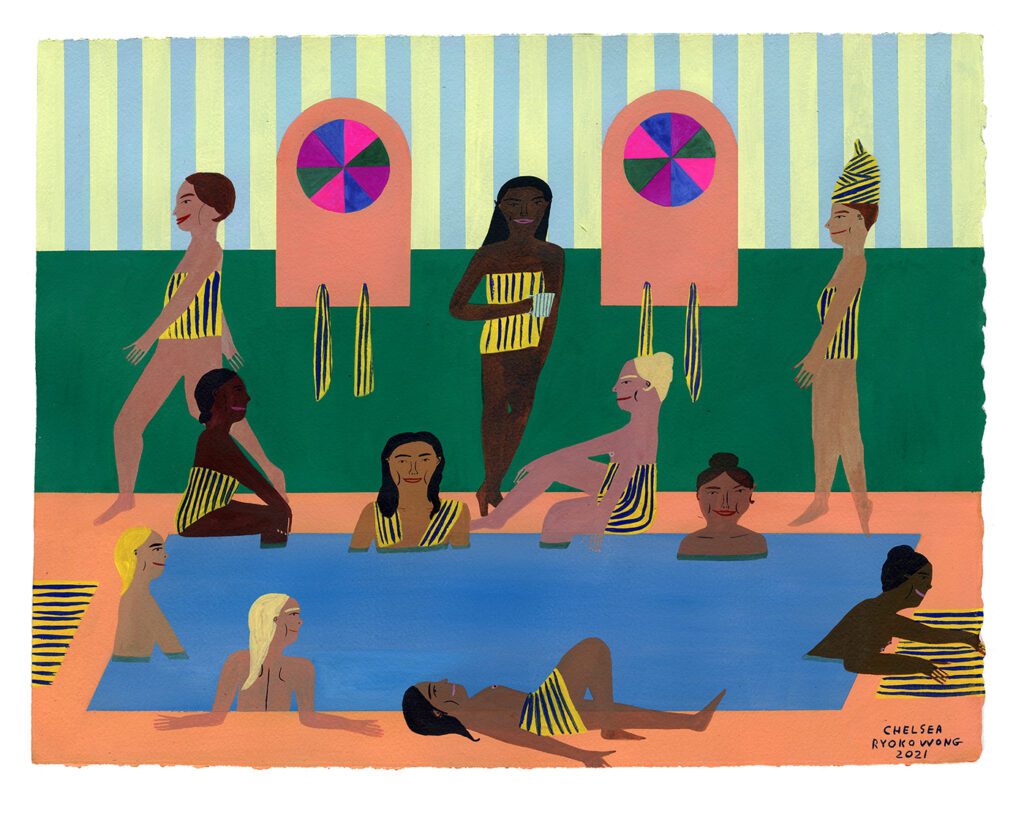
It is just as important to stop and take the time to peruse the zines and read the letters and journal entries carefully curated by J Wu. The display takes up one and a half walls of the first room and it is perhaps the most intimate experience of queer Asian women and gender-queer people learning the intimate language of naming and recognizing themselves and the issues they faced from fat-shaming to homophobia.
The only other artwork that comes closer is Hong Kong artist Nicole’s “Inside and Out Series (2014-2018),” which explores lesbian Taiwanese and Hongkonger’s hands in a series of photos.
“I want the exhibition to speak to CCC’s intersecting communities of Asian Americans, queer and trans people, and immigrant communities of color,” said Hoi, who believes that Black, brown, indigenous, and people of color transgender and nonbinary people are “central to today’s feminist discourse.”
“This exhibition aims to affirm the importance in cultivating safe spaces as vital to cultivating queer and feminist creativity and cultural growth,” said Hoi, who wants the center’s exhibit to speak to the “intersecting communities of Asian Americans, queer and trans people, and immigrant communities of color,” she said.
More than 5,000 people have seen the exhibit since it opened in May. Hoi anticipates upward of 20,000 people will walk through the exhibit by the time it closes on December 18.
This small exhibit is rich with texture, filled with profound meaning, and gives viewers within the Asian queer women’s culture a sense of affirmation and belonging and those familiar and unfamiliar with the culture a rare window into the soul of the community. No matter where you are on the spectrum, you will leave the exhibit changed for the better.
THE GAZE:
“WOMEN我們: From Her to Here at the San Francisco Chinese Cultural Center, 750 Kearny Street, 3rd Floor, San Francisco, California 94108. 415-986-1822. . cccsf.us/post/women%E6%88%91%E5%80%91-from-her-to-here.
Appointments are preferred to see the exhibit for COVID-19 precautions. Social distancing, masks, and sanitation are available at the exhibit.
TYPE OF EVENT: Exhibit
RATING: 4
(0 being the worst rating and 5 being the best rating)
VIBE: Quiet and pensive.
SCENE: Casual, not crowded.
SERVICE: Everyone at the Chinese cultural center of San Francisco was very welcoming and helpful.
The exhibit is on the edge of Chinatown and the Financial District on the third floor of the Hilton Hotel across from historic Portsmouth Square on Kearny Street between Clay and Washington streets. I highly suggest, if you are driving park in the garage (which the entrance is in the far-left lane on Kearny) beneath the square and crossing over the foot bridge and up the stairs to the upper level into the center. The center’s gallery is on the left-hand side near the entrance.
If traveling by ride share or taxi, pull into the Hilton Hotel’s passenger drop off and take the elevator to the left in the lobby as soon as you enter the hotel, to the third floor.
If traveling by public transportation take any Muni bus on Kearney Street heading toward Fisherman’s Wharf or the California 1 bus from the Outer Richmond neighborhood through Pacific Heights and Nob Hill down into Chinatown.
DAZZLE ME AGAIN: Expect to be drawn in and immersed into queer Asian women’s world. I want to go again as I did not spend as much time as I should have at the exhibit, there is that much to explore and learn about.
WHERE TO NEXT?: To be determined
THE TICKET: $ = Under $10 suggested donation.
WORTH THE OUTTING?: This was a rock’n good time! =
Book your next romantic getaway to the Caribbean with Girls That Roam Travel. Contact Heather Cassell at Girls That Roam Travel at 415-517-7239 or at .
To contract an original article, purchase reprints or become a media partner, contact .



















